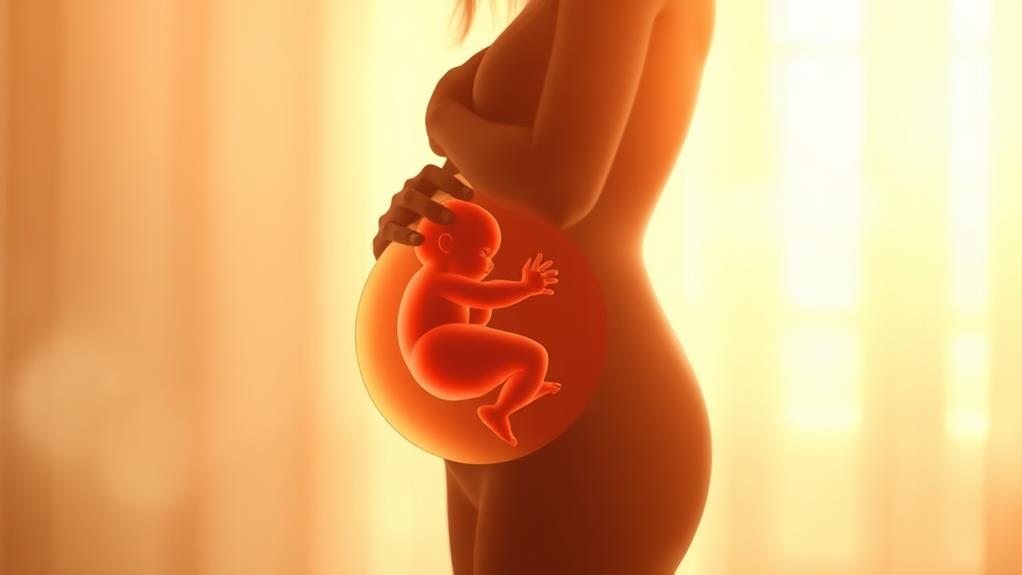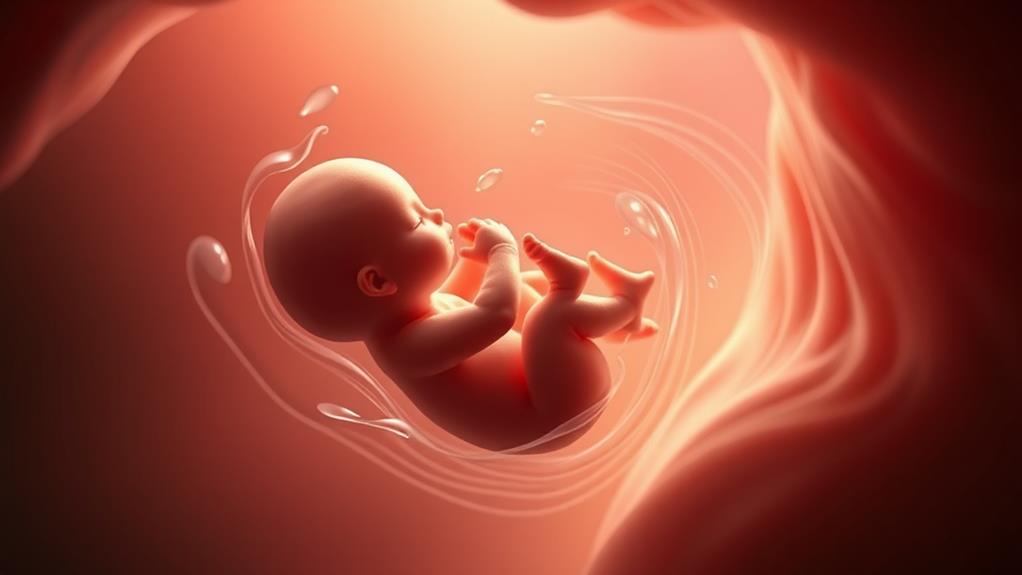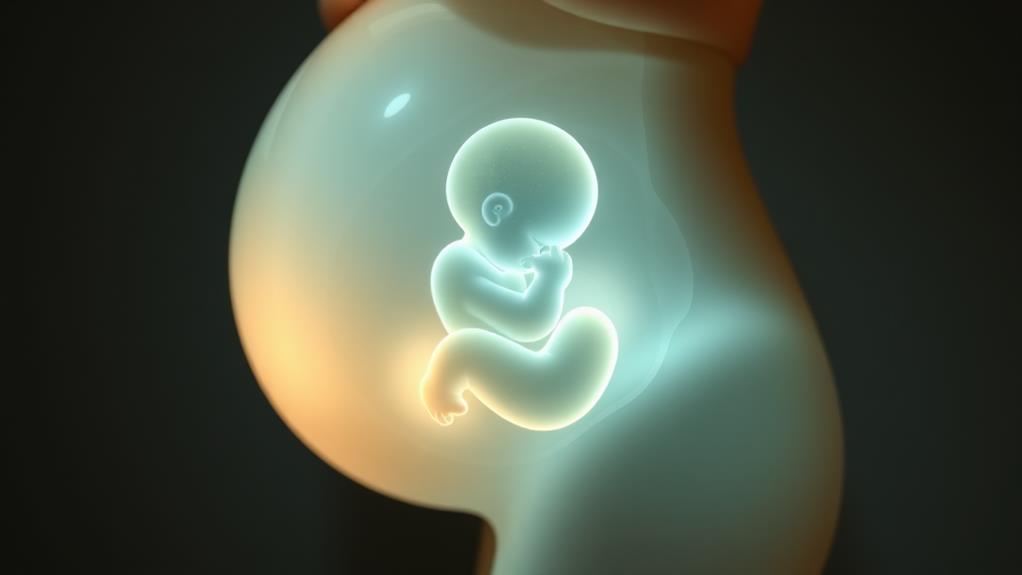17 Secrets Of Baby Behavior In The Womb
When you think about a baby’s development, you might imagine simple growth, but there’s much more happening in the womb than you realize. From their first movements to their responses to sounds and even the flavors of your meals, these behaviors can shape their future. You may be surprised to learn how factors like sleep cycles and maternal stress play a role in their early lives. What does this mean for you and your baby’s bond? The answers might change how you view pregnancy entirely.
Fetal Movement Patterns

During pregnancy, understanding fetal movement patterns offers essential insights into your baby’s development. You might start feeling those little kicks and wiggles around the 20-week mark. It’s like your baby’s way of saying, “Hey, I’m here!” These movements can tell you a lot about how your baby is growing.
At first, the movements might be soft, like a gentle flutter, but as your baby gets bigger, you’ll notice more pronounced kicks and rolls. You’ll probably start to recognize a pattern, too. Babies tend to be more active at certain times, especially when you’re relaxing. It’s almost like they’re dancing to your favorite tunes.
Paying attention to these movements can help you feel more connected to your little one. If you notice a change in their activity, it’s important to bring it up to your doctor.
Reaction to Sound
Babies in the womb can actually hear sounds from the outside world, and this ability starts developing early in pregnancy. By around 25 weeks, your little one can pick up on your voice, music, and other noises. It’s like they’ve got their own little sound system in there!
When you’re chatting or singing, your baby might respond with kicks or twists. It’s as if they’re saying, “Hey, I can hear you!” Their reactions can be pretty fascinating. Loud noises, like a dog barking or a door slamming, might cause them to jump or move around more. That’s their way of reacting to the world outside.
Interestingly, babies become familiar with certain sounds, like your voice or even the rhythm of your favorite songs. After birth, they might seem to recognize these sounds, which can be comforting for them.
Sensing Touch

Your baby also picks up on pressure. If you lean against your belly, they can sense that too, like a little hug from the outside world. Isn’t that sweet?
This ability to feel touch helps your baby connect with you even before they’re born. It’s like they’re practicing for all those cuddles you’ll share later.
As they grow, they’ll start to explore their little world with their hands and feet, feeling the walls of the womb. They might even get a little playful, pushing against the sides.
Taste Preferences
Significantly, research shows that fetuses often develop taste preferences while still in the womb. Isn’t that amazing? Your little one can actually taste the flavors of the food you eat! When you munch on garlic or savor spicy dishes, those flavors can reach your baby through the amniotic fluid.
Studies suggest that if you snack on carrots, chocolate, or even pizza, your baby might start to prefer those tastes.
So, what does this mean for you? If you want to introduce your baby to a variety of flavors, it’s a great idea to eat a balanced diet filled with different tastes. Think of it as a culinary adventure for both of you!
You might wonder how this affects your baby after birth. Well, some researchers believe that babies whose moms ate a diverse range of foods during pregnancy might be more open to trying new flavors once they start eating solids.
Of course, every baby is different. Some might love broccoli, while others might turn up their noses at it! Just remember, your food choices in pregnancy could help shape your little one’s taste buds. Now, that’s food for thought!
Sleep Cycles

During pregnancy, you might be surprised to learn that your baby develops sleep cycles while still in the womb. That’s right! Even though your little one can’t exactly pull up a blanket, they’re already figuring out when to snooze and when to wiggle.
Around 25 weeks, your baby starts to experience REM sleep, which is the deep, dream-filled rest that helps with brain development.
You may notice that your baby’s movements seem to calm down at times. That’s likely when they’re catching some Z’s. But don’t get too cozy yourself! Your baby might also have some energetic dance parties, especially when you’re trying to relax.
These sleep cycles can vary, with some babies sleeping for longer stretches while others are more active. It’s like having a tiny, unpredictable roommate!
As your pregnancy progresses, you’ll start to notice patterns in when your baby is awake or asleep. Keep in mind that each baby is unique, so embrace those differences.
Breathing Movements
From around 20 weeks, babies start practicing breathing movements in the womb, which is essential for their development. Isn’t that amazing? Even before they take their first breath outside, they’re already getting ready!
You might wonder how they do this. Well, they’re not breathing air like you and I do. Instead, they’re practicing by moving their tiny diaphragm up and down, mimicking the breathing process.
These movements help strengthen their lungs and prepare them for life outside the womb. You might even feel little kicks or flutters when they’re doing this! It’s like a tiny dance party happening right inside your belly.
As the weeks go by, these breathing movements become more regular. It’s one of those signs that your baby is growing and getting ready for the big day.
And guess what? Some studies suggest that these movements can help your baby feel calm and relaxed. So, every time you feel those little wiggles, remember—they’re not just having fun; they’re getting ready to take on the world!
Keep enjoying those moments; they’re more special than you might think!
Swallowing Reflex

The swallowing reflex is another fascinating skill your baby develops while in the womb. From about 12 weeks into your pregnancy, your little one starts practicing this important action. It might sound surprising, but babies actually swallow amniotic fluid! This fluid helps them practice the movements they’ll use after birth, when they’ll be sipping milk and maybe even munching on baby food.
You might be wondering, what’s the big deal about swallowing in the womb? Well, it helps your baby’s digestive system get ready for the outside world. By swallowing, your baby stimulates the development of their throat muscles and digestive organs. It’s like a little workout session in there!
As your baby swallows, they also get a taste of the flavors in your diet. So, if you eat something spicy or sweet, your baby might be experiencing those flavors too—it’s a tiny gourmet adventure!
Just think, your little chef is hard at work, preparing for mealtime in the real world. Isn’t that adorable? So, while you’re marveling at those little kicks and rolls, remember that your baby’s swallowing reflex is a key part of their growth journey.
Yawning and Hiccups
As your baby practices swallowing in the womb, you might also notice some other intriguing behaviors like yawning and hiccups. These little actions are quite common and can be pretty adorable to think about!
Yawning often happens when your baby is getting comfy or relaxing. It’s like a tiny stretch for them, showing that they’re settling in or just taking a moment to breathe.
Now, hiccups? Those can be even more amusing! You might feel rhythmic little jolts in your belly, and that’s your baby’s way of learning how to control their diaphragm. Hiccups usually happen when they swallow amniotic fluid, and while they might seem silly, they’re perfectly normal.
Watching for these behaviors can be a fun way to connect with your baby. It’s like a sneak peek into their little world!
Response to Light

During pregnancy, you might be surprised to learn that your baby can respond to light, even while nestled in the womb. It’s like having a little theater inside you! When you shine a light on your belly, your baby can actually sense it. Research shows that around the 26th week of pregnancy, your little one starts to react to light by moving or shifting positions. Isn’t that amazing?
Imagine your baby, cozy and snug, doing a little dance when they see a beam of light! It’s their way of exploring the world, even before they’re born. They mightn’t fully understand what light is, but they can definitely feel its effects. This response might help them prepare for life outside, where light and dark will be a big part of their day.
You might even notice more kicks or wiggles when you expose your belly to different light sources. It’s like a fun game between you and your baby!
Positioning in the Womb
After exploring how your baby responds to light, it’s fascinating to contemplate how they position themselves in the womb. You might think that with all that space, your little one just floats around like a balloon at a party, but it’s not quite that simple!
Babies actually have preferred positions, and they often settle into a cozy spot, usually with their head down, preparing for the big day.
As they grow, your baby learns to twist, turn, and even wiggle their tiny limbs. You may feel those little kicks, which are their way of saying, “Hey, I’m here!”
Positioning matters because it can affect their development and help them get ready for birth. They might even shift around when they hear sounds or feel pressure, responding to the world outside.
It’s pretty amazing to think about how much they’re moving and grooving in there. Just remember, every baby is different, so don’t worry if yours seems to have a unique favorite spot. They’re just getting comfortable before making their grand entrance into your life!
Connection With Mom

A baby’s connection with mom starts long before birth, creating a bond that’s both profound and instinctive. Even in the womb, your little one can sense your presence. They hear your voice, feel your movements, and even pick up on your emotions. Isn’t that amazing?
As you go about your day, your baby’s listening to the rhythm of your heartbeat, which becomes a soothing lullaby for them. When you talk, sing, or laugh, those sounds travel through the amniotic fluid, creating a comforting environment. It’s like a secret world just for the two of you!
Your baby also responds to your daily activities. When you’re active, they might wiggle and move around, but if you’re relaxing, they might calm down too. This connection helps your baby learn to recognize your unique patterns and rhythms, which can even make them feel safe.
Emotional Responses
Your baby picks up on your emotional responses even while nestled in the womb. It’s true! When you feel happy, sad, or even anxious, your little one can sense those emotions. Isn’t that amazing? The connection between you and your baby is stronger than you might think.
When you experience stress, your body releases hormones like cortisol. These hormones can travel through the placenta, reaching your baby. This means they’re not just floating around; they’re feeling the vibe! If you’re feeling calm and relaxed, your baby may feel that positive energy too. It’s like a little emotional party happening in there!
So, how can you create a happy atmosphere? Surround yourself with things that make you smile—like your favorite music or a good book. Talking and laughing with loved ones can also help lift your spirits.
Just remember, it’s okay to feel a range of emotions; you’re human after all!
Your baby is learning about the world from you, so try to keep things light-hearted when you can. After all, you’re not just nurturing their body; you’re nurturing their feelings too! Keep that emotional connection strong!
Movement and Development

Many expectant parents are surprised to learn that babies begin moving in the womb as early as eight weeks into pregnancy. At first, these movements are tiny and feel more like fluttering or gas bubbles.
But as the weeks go by, those little flutters turn into more noticeable kicks and rolls. By around 20 weeks, you might start feeling those delightful nudges that remind you there’s a tiny person growing inside you!
These movements are vital for your baby’s development. They help strengthen their muscles and bones, allowing them to prepare for life outside the womb.
You might even notice patterns in their activity, with some babies being more active at certain times of the day—maybe they’re night owls like you!
As your pregnancy progresses, you’ll experience a variety of movements, from gentle stretches to enthusiastic kicks. It’s a sign that your baby is alive and well, practicing their dance moves for the big debut.
Impact of Nutrition
Nutrition during pregnancy plays an essential role in your baby’s development and overall health. What you eat doesn’t just fill your tummy; it helps create a cozy environment for your little one. If you think about it, your baby’s getting all those nutrients through you, like a tiny chef sampling your meals!
Eating a balanced diet rich in fruits, veggies, whole grains, and lean proteins gives your baby the best start. These foods provide crucial vitamins and minerals, like folic acid, which helps prevent certain birth defects. Plus, omega-3 fatty acids found in fish can boost brain development. Who knew dinner could be brain food?
Don’t forget about hydration, either! Drinking enough water keeps things flowing smoothly—literally! It helps with the amniotic fluid that surrounds and protects your baby.
Of course, indulging in your cravings now and then is okay, but focus on nutritious choices most of the time. Think of it as filling your baby’s pantry with healthy goodies.
After all, a well-fed baby is a happy baby, and who doesn’t want a happy little buddy? So, dig into those nutritious meals and enjoy this special journey together!
Influence of Stress

Stress often creeps into pregnancy, and its effects can be more significant than you might realize. When you’re stressed, your body releases hormones like cortisol, which can affect your baby while they’re still in the womb.
Imagine your little one feeling your emotions; it’s like they’re riding an emotional rollercoaster!
High stress levels can lead to changes in your baby’s behavior, too. They might be more fussy or reactive once they’re born. Plus, studies show that babies exposed to high stress during pregnancy might be more prone to anxiety later in life.
So, it’s important to find ways to manage your stress. You could try yoga, deep breathing, or even just chatting with a friend.
Taking time for yourself isn’t selfish; it’s necessary! Your baby can sense your mood, so keeping a positive outlook can help create a peaceful environment for them.
Genetic Factors
Genetic factors play an essential role in shaping your baby’s behavior even before they’re born. Each baby inherits a unique set of genes from you and your partner, and these genes can influence their temperament and personality.
For instance, if you or your partner are known to be calm and laid-back, your baby might inherit those traits. On the flip side, if you both have a bit of a fiery side, your little one may be more spirited!
Isn’t it amazing how much influence you have? Genetic factors can also affect things like sleep patterns and even how responsive your baby is to sounds. If you’re a music lover, your baby might already be grooving to the tunes in the womb!
However, remember that genetics isn’t the whole story. Your baby’s environment, including your health and emotional state during pregnancy, also plays a big part.
Preparing for Birth

As you approach the final weeks of pregnancy, preparing for birth becomes an exciting yet essential task. You might feel a mix of excitement and nervousness as you gather everything you need.
First, it’s time to pack your hospital bag! Include comfy clothes, toiletries, and items to keep you entertained during those waiting hours. Don’t forget snacks—trust me, you’ll want them!
Next, consider creating a birth plan. This isn’t a strict contract, but it’s a way to express your wishes for the big day. Think about who you want in the room, any pain relief options, and your preferences for baby care right after birth.
Also, practice relaxation techniques. Breathing exercises or gentle yoga can help calm those pre-birth jitters. It’s like preparing for a big game—you want to be relaxed and focused when the moment arrives.
